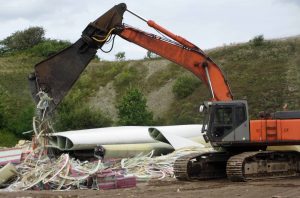
Building – and then decomissioning – wind turbines imposes significant environmental costs. The towers, the mechanics and the assorted parts to make it work need to be constructed using various materials.
To date, one big problem has been what to do with old wind turbine blades. It is good to see a Danish startup, Miljøskærm, propose a solution: using the blades to build noise insulation walls. Until now, the turbine blades have substantially been sent to landfill.
The Danish word “Miljøskærm” does not easily translate to English. It is a combination of the Danish words for “environment” and “shield” implying the intention of shielding our environment for depositing of non-degradable products as glass fiber in landfills as well as reducing the continuously increasing demand for virgin materials. Further, it refers to the application of recycled glass fiber in sustainable traffic shields / noise barriers.
Miljøskærm
The question of what to do with aging blades only emerged over the last five years or so as the first wind turbines reached the end of their lives after more than two decades of service. The need for a better solution than landfills has steadily increased as the newest blades in use have grown increasingly larger. That’s spurred a mini-industry of companies with new ideas on how to recycle them.
Bloomberg Green
This is the sort of creative innovation that an open economy is great at creating. Solving two problems with one potential solution, and rewarding the people who come up with good and effective ideas!

It would have been nice to have seen some facts about what issues there are around the disposal of wind turbines. Like the materials used that might be difficult to recycle for example. Instead of three short paragraphs and two quotes with no substance.
Perhaps looking at the environmental costs of disposing of turbines against decommissioning a coal-fired power station?
It feels like a story to someone who is the verge of tipping a toe into the pool of climate scepticism, if not fulling swimming already.
Interesting that an EU country is highlighted as an open economy, which seems counter to statements made previously.
I think these developments are good! They should help to reduce the impact of wind turbines – so we can improve the benefits and reduce the costs.